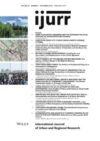The infrastructural turn in urban studies has revealed a different side of metropolitan life—one lived through roads, buildings, pipes, sewers and trains. Two books on Indian cities tell the story of infrastructure, albeit with a twist, as both books examine infrastructure ‘on the move’. Specifically, the authors focus on those who labour on this moving infrastructure—here one moment, gone the next. Mumbai Taximen: Autobiographies and Automobilities in India, shows how the taxi drivers not only traverse a complex and growing city, but also have to navigate changing regimes of pollution and regulation. When their taxis are deemed too old for modern Mumbai, the drivers become more deeply embedded in networks of taxi-kin to care for their ageing cars as well as their own ageing bodies. The Industrial Ephemeral: Labor and Love in Indian Architecture and Construction outlines the material, sensorial and financial lifecycles of the work of construction. The author argues that the durability of the buildings stems from precisely the non-durability—i.e. the ephemerality—of the labour that builds them.
In Mumbai Taximen, Tarini Bedi paints a vivid picture of a community linked together through relationships of kin, neighbourhood, materiality and livelihood. This community, called Chillia, is composed of hereditary taximen (Gujarati-speaking Sunni Muslims) who have been driving Mumbai city’s iconic black and yellow taxis since the 1970s. Over the last two decades, pollution regulations have made their cars (manufactured by a now defunct company called Premier automobile) emblematic of an old regime of Indian automobility. Drawing from Svetlana Boym’s concept of the ‘oft-modern’, Bedi shows how drivers resist the regulatory regime’s marking of their taxis—and by extension, of them—as an outdated phenomenon.
In addition to the Introduction and Conclusion, Mumbai Taximen consists of six chapters. The first two chapters outline the economic and material underpinnings of taxi driving in Mumbai. The drivers’ everyday routines are marked by economic obligations, sensory confrontations with the traffic, dust and heat, and a new system set up to modernize taxi driving in Mumbai. Several members of the kin-group drive, help care for, finance, repair, maintain and wash the taxis in order to extend the longevity of the cars and the trade.
The following three chapters titled Joona, Jallu and Dekh-Baal are the book’s finest. In the first of these, Bedi uses the emic term ‘joona’ to showcase the drivers’ claims to authenticity: to being the original drivers of the city. More than an evocation of nostalgia, this claim is emblematic of the drivers’ politics of refusal. They refuse ‘the state’s material devaluation of an artefact of transport, and they refuse its declaration that both the extant structure of labour and the aging bodies of the men who drive are obsolete and out of step with a modern future’ (p. 92). In Jaalu, we learn how the trade depends on kin and kin-like relationships built up in the neighbourhood. The Chillia women’s piecework performed at home, in which they decorate small plastic items of adornment, may seem de-linked from taxi work. However, it plays a crucial role in building and maintaining links with extended family and community. These relationships are crucial, and the drivers depend on them to navigate the uncertain world of taxi permits, financing, repair and sale. The chapter called Dekh-Bhal shows how the drivers double up as mechanical repairmen and possess a deeply embodied, sensory and tacit knowledge of the mechanics of the car. While driving, during rest stops and in the communal spaces of the crossroads (naka), these driver-mechanics collectively tinker about in their own and others’ cars, diagnosing faults and repairing them.
Several taxi unions and organizations exist and regularly intervene in the modernization debate, which is discussed in chapter 6. Yet their allegiances are to political parties or to the transnational financing of infrastructure road projects. They do not engage with the social and sensory labours of driving or the relationships between taxis and communities, which—as Bedi shows—form the bedrock of Indian automobility.
The Industrial Ephemeral has a similar structure to Mumbai Taximen, being comprised of six chapters in addition to the Introduction and Conclusion. Trained as an architect, Namita Vijay Dharia both draws from and analyses her training to focus our attention on construction beyond the architect’s designs. Her writing weaves a compelling narrative of the ephemeral core of the construction industry. As she writes: ‘not only does it depend on its workers’ ability to disappear from one site and move to another, but its constitutive processes—from site surveying to construction to project completion—are based on a set of continuous transformations that displace and erase previous atmospheres, materials, and work’ (p. 3).
The book’s first three chapters narrate the macro story of the political economy of the infrastructure boom in the state of Haryana, adjoining the national capital Delhi. Parts of Haryana were incorporated into the National Capital Region (NCR), which involved the large-scale private purchase of land from locals with the aim of redeveloping them as middle-class residential and commercial real estate. While some parts of the NCR have been built up, many plots remain imbricated in speculative financial deals. Drawing from the theory of the subliminal, Dharia suggests that the ‘financial subliminal’ entails both terror and wonder at the generative abilities of money and speculation. Locals from the dominant caste groups, architects, building contractors as well as international financing companies participate in this financial sublimation. The promise of manifold wealth and fast-tracked social mobility is not always fulfilled, generating multiple flows of bribes, hoarding and shady deals—ubiquitously known as the ‘black money’ operation of the construction business.
The second half of the book (chapters 3 to 6) zooms in on the material and sensorial experiences of workers employed to realize the fantastical plans and subliminal financial promises. They train themselves to work with the particular tempos, materials and soundscapes of construction. The myth of rapid mobility exists here too but—as in the financial equivalent—it is a patchwork of fantasies and loopholes. Within the hierarchies of construction, being a quick learner (tez) means that a labourer might become a skilled worker (karigar). Workers produce their own fantastical designs of mobility, shoring up their precarious circumstances and poverty (majboori) that feeds the construction industry through acts of labouring (majdoori). The latter gives them the means to overcome their circumstances by providing some options to gain a foothold in urbanizing spaces, develop their skills and embed themselves in the networks that are crucial to accessing the next work opportunity. This pattern continues until the body wears out, often already by age 40, and manifests ‘the worst form of ephemeral: that of a shortened life span or premature death’ (p. 151). Lastly, in showing how the temporariness of the workers’ labour forms the bedrock of the business, Dharia reveals how their political action may also be examined through the lens of ephemerality. The workers’ calls for justice are at once tenuous and fleeting but also generative of alliances and affinities.
Both authors bring to bear the aesthetic and aspirational economies of the contemporary urban condition in their writing, and they share two goals. The first is to foreground the role of the sensory: taxi drivers and constructions workers have to reckon with the aesthetic of modern city-making, wherein what looks old (taxis) or incomplete (buildings) must quickly give way to that which is new, modern, built-up and durable. Both books do an excellent job in showing that it is the sensorial, transient and processual work of taxi driving and construction which in fact creates value in both businesses. Whether it is providing mobility for customers or buildings for residents and new offices, these cannot exist without the ephemeral work of the drivers and construction workers—who in turn use this work to help carve out their own desires and aspirations for recognition, intergenerational mobility, kinship and love in the city.
The second aim is to show how this ephemerality takes the form of political, financial and social erasure. The authors do not reduce the workers’ mobility and ephemerality to narratives of invisibility within the larger city. Instead, through their narratives of movement, Bedi and Dharia underscore how the workers’ labour only shifts out of sight without disappearing completely: it leaves sensory traces, narrative designs and aspirational materialities on the urban landscape. The drivers’ and builders’ connective linkages to materials, spaces and communities emerge as the durable underpinning on top of which they keep circulating, seeking out work, and making claims on the city, however ephemerally.
Maansi Parpiani, University of Copenhagen
Tarini Bedi 2022. Mumbai Taximen: Autobiographies and Automobilities in India. Seattle, WA: University of Washington Press. Cover used with permission of University of Washington Press.
Namita Vijay Dharia 2022. The Industrial Ephemeral: Labor and Love in Indian Architecture and Construction. Oakland, CA: University of California Press. Cover used with permission of University of California Press.
Views expressed in this section are independent and do not represent the opinion of the editors.

